The Radeon HD 4850 & 4870: AMD Wins at $199 and $299
by Anand Lal Shimpi & Derek Wilson on June 25, 2008 12:00 AM EST- Posted in
- GPUs
Building a RV770
We did this with NVIDIA's GT200 and it seemed to work out well, so let's start at the most basic level with AMD's RV770. Meet the Stream Processing Unit:
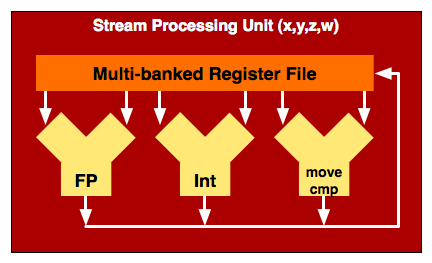
AMD's Stream Processing Unit is very similar to NVIDIA's SP in G80/G92/GT200, so similar in fact that I drew them the same way. Keep in mind that the actual inner workings of one of these units is far more complex than three ALUs but to keep things simple and consistent that's how I drew it (the actual hardware is a fused FP MUL + ADD unit, for those who care). AMD has four of these stream processing units in a processor block and they are called x, y, z or w units.
There's a fifth unit called a t-unit (the t stands for transcendental, meaning the type of operations it is capable of processing):

The t-unit can do everything a x,y,z or w-unit can do, but it also can do transcendental operations (represented by the SFU block in the diagram above). NVIDIA has the same functionality, it simply chooses to expose it in a different way (which we'll get to shortly). AMD considers each one of these units (x,y,z,w and t) a processing unit, and the RV770 has 800 of them (the RV670 had 320).
AMD pairs four of these stream processing units (x,y,z and w) with a t-unit and puts them together as a block, which I have decided to call a Streaming Processor (SP):

The area in red is actually the SP, but unlike one of NVIDIA's SPs, one of AMD's can handle up to five instructions at the same time. The only restriction here is that all five units have to be working on the same thread.
AMD then groups 16 of these SPs into something they like to call a SIMD core (AMD has less confusing, but far worse names for its architectural elements than NVIDIA):
|
AMD's SIMD Core
|
NVIDIA's SM
|
 |
 |
A SIMD core is very similar to NVIDIA's SM with a couple of exceptions:
1) There are more SPs in AMD's SIMD Core (16 vs 8)
2) The SPs are wider and can process, at peak, 5x the number of instructions as NVIDIA's SPs
3) The Instruction and Constant caches are not included in the SIMD core, AMD places them further up the ladder.
4) AMD pairs its texture units and texture cache with its SPs at the SIMD core level, while NVIDIA does it further up the ladder.
5) See the two SFUs in NVIDIA's SM? While NVIDIA has two very fast Special Function Units in its SM, AMD equips each SP with its own SFU. It's unclear which approach is actually faster given that we don't know the instruction latency or throughput of either SFU.
Note that at this point, the RV770 is really no different than the RV670 (the GPU used in the Radeon HD 3870). The next step is where AMD and NVIDIA really diverge; while NVIDIA's GT200 takes three SMs and groups them into a Texture/Processing Cluster (TPC) and then arranging 10 TPCs on its chip, AMD simply combines 10 SIMD cores:
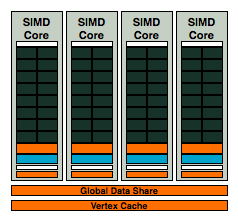
AMD's RV670
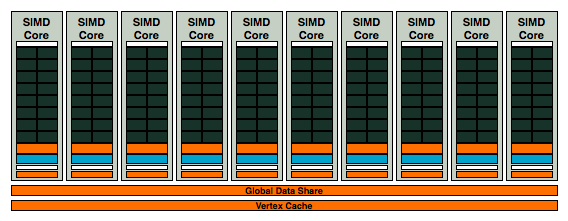
10 SIMD cores at your disposal in AMD's RV770, this is how AMD goes from competitive, to downright threatening
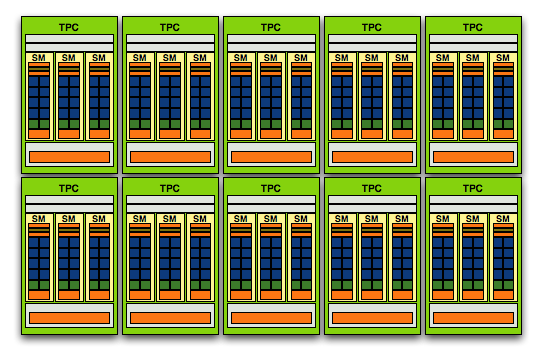
NVIDIA's GT200 Streaming Processor Array (SPA), it has fewer execution resources but more encapsulation around them, the focus here is on thread management
With 10 SIMD cores the RV770, it has 2.5x the number of execution units as a RV670. It even has more theoretical processing power than NVIDIA's GT200. If you just look at the number of concurrent instructions that can be processed on RV770 vs. GT200, the RV770's 800 execution units to GT200's 240 (+ 60 SFUs) is in a completely different league.
| NVIDIA GT200 | AMD RV770 | AMD RV670 | |
| SP Issue Width | 1-way | 5-way | 5-way |
| # of SPs | 240 | 160 | 64 |
| Worst Case Dependent Instruction Throughput | 240 | 160 | 64 |
| Maximum Scalar Instruction Throughput | 480* | 800 | 320 |
We'll be talking about efficiency and resource utilization in the coming pages, but immediately you'll notice that the RV770 (like the RV670 and R600 that came before it) has the potential to be slower than NVIDIA's architectures or significantly faster, depending entirely on how instruction or thread heavy the workload is. NVIDIA's architecture prefers tons of simple threads (one thread per SP) while AMD's architecture wants instruction heavy threads (since it can work on five instructions from a single thread at once).
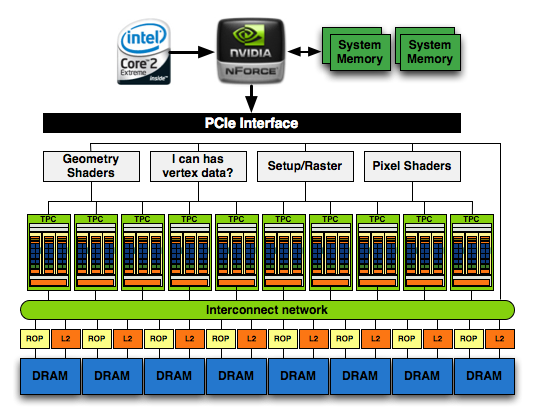
NVIDIA's GeForce GTX 280
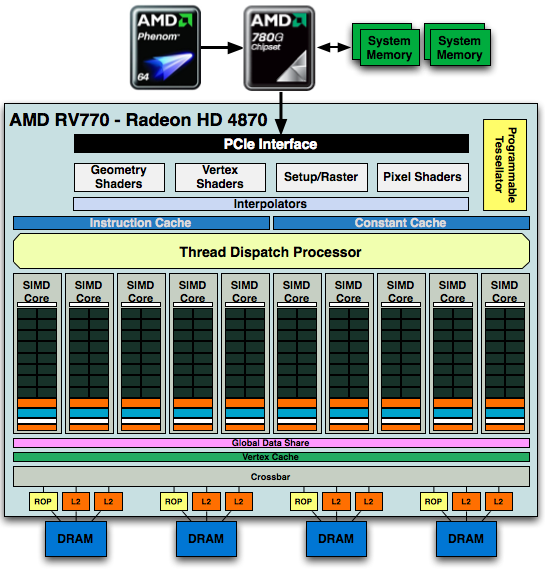
AMD's Radeon HD 4870
The full GPU is pretty impressive:
1) See the Instruction and Constant Caches up top? NVIDIA includes them in each SM while AMD seems to include them outside of the SIMD core clusters.
2) The RV770 only has four 64-bit memory controllers compared to the eight in GT200
3) The Programmable Tessellator is left over from the Xbox 360's GPU (and R600/RV670), unfortunately it is unused by most developers as there is no DirectX support for it yet.
4) AMD has dedicated hardware attribute interpolators, something NVIDIA's hardware shares with its special function units (SFUs).
Other than the differences we mentioned above, AMD's architecture is similar in vain to NVIDIA's, there are just a handful of design choices that set the two apart. Just like NVIDIA took its G80/G92 architecture and made it larger, AMD did the same with RV770 - it took RV670 and more than doubled its execution resources.
AMD took a bigger leap with RV770 from RV670 than NVIDIA did from G80/G92 to GT200, but it makes sense given that AMD had to be more competitive than it even was in the last generation.










215 Comments
View All Comments
Amiga500 - Wednesday, June 25, 2008 - link
Apple has passed over control of Open CL to the Khronos group, which manage open sourced coding.To all intentions and purposes, it is open source. :-)
emergancyexit - Wednesday, June 25, 2008 - link
i hope you do 3x crossfire can do. maybe a 4x 4850 vs 3x GTX 260 just to satisfy us readers for the moment would be lovely!DerekWilson - Wednesday, June 25, 2008 - link
i'm not sure if this is supported out of the box ... ill have to check it out ...emergancyexit - Wednesday, June 25, 2008 - link
i would really like to know what type of performance theese cards could get in an MMO. (and hopefully compare them to some cheaper cards) Games im interested in are some of the newer titles like Age of conan ( i hear it's graphics are great and is a workout for even a 8800 ultra) And Eve-online (thier new graphics engine works cards pretty hard too)MMO's Graphics usually get pretty intesive with some odd 200+ characters flying around shooting fireballs evrywhere with missles sailing through the air in a land of hundreds of monsters as far as the eye can see. it can get pretty demanding on a gameing computer, just as much (if not more) as a hit new title.
for example, on my current Rig i can get around 50FPS steady at 1440x900 but on Eve-Online i get 35 at the most at peacefull times and 20 or even 15 in a large fight with FEW graphics options selected.
MIP - Wednesday, June 25, 2008 - link
Great review, the 4870 looks to be fantastic value. However, we're missing the 'heat and noise' part.skiboysteve - Wednesday, June 25, 2008 - link
Not only do these cards rock, but I wouldn't be surprised if AMD has an ace up its sleeve with the 4870x2... with that crossfire interconnect directly connected to the data hub that you showed on the chart. That and the fact that they have been looking forward to this crossfire strategy of attacking the high end for quite some time so they might have some tricky driver stuff coming with it.I have been disappointed with the heat and power consumption of these cards. But:
1) Someone said powerplay is getting a driver tweak and, I can always clock them lower in 2D than 500/1000 (which is insane for 2d)
2) That hardware site someone linked earlier showed a more than 50% reduction in temperatures with an aftermarket cooler! Thats insane!!
And finally, if I can get the 1 & 2 fixed... I want to know how well these babys overclock. If I can get a 4850 running like a 4870 or better... yum. And in that case, how high will a 4870 OC? And I want to know this with a non stock cooler, because apparently the stock ones suck. With a non stock cooler if the 4850 clocks up to 4870 level, but the 4870 clocks way up too... i'm gonna have to grab a 4870.
So yeah, fix #1 and #2 and find me non-stock cooler OC #s and I'll go buy one (maybe two?) when nehalem comes out
Powered by AMD - Wednesday, June 25, 2008 - link
Impressive review, Thanks :)A few glitches:
It says "Power Consumption, Heat and Noise", but the graphs only shows Power Consuption.
In Page 17 (The Witcher), in second paragraph, it says 390X2 instead of 3870.
Thanks again.
Cheers from Argentina.
Conscript - Wednesday, June 25, 2008 - link
atleast that was the tile of the second to last page...but only see two power consumption graphs?Proteusza - Wednesday, June 25, 2008 - link
I quote one Kristopher Kubricki regarding whether the RV770 is inferior to the GT200:"It is. Even AMD isn't going to tell you otherwise. You can debate this all you want, but it's still a $200 video card."
So, please tell me now why I should pay $650 for a GTX280. I'm struggling to see the logic here.
Source: http://www.dailytech.com/Update+AMD+Preps+Radeon+4...">http://www.dailytech.com/Update+AMD+Pre...50+Launc...
(near the bottom)
AbRASiON - Wednesday, June 25, 2008 - link
I can live with a greedier card than my 8800GT but I refuse to put up with a noisy machine.Any comments on the heat and noise please? would be nice!